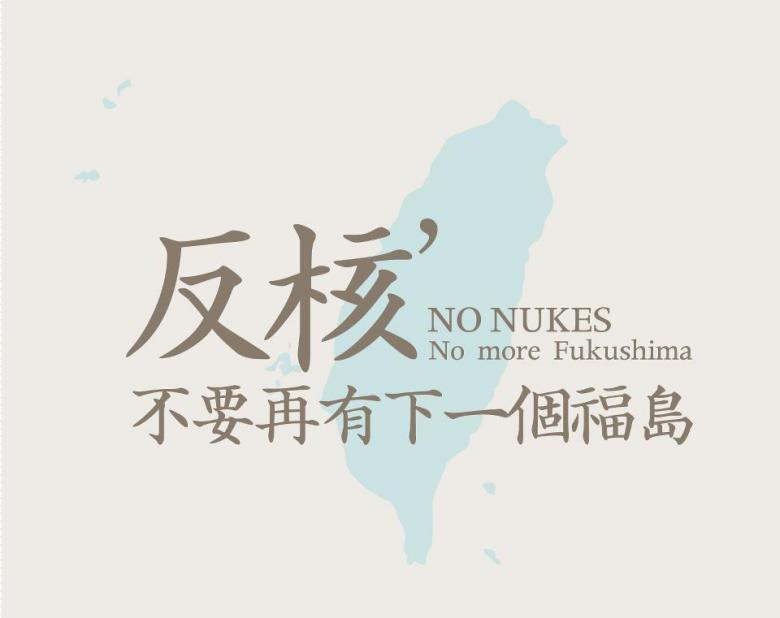Nuke 4 - The story of the Lungmen Nuclear Power Plant leading up to the 427 protests
The protests against Nuke 4 have started again in earnest, and recently you may have seen banners, flags, or signs like this pinned up around town:
Of course, we all know about the Fukushima Daiichi nuclear disaster that happened back in 2011, but even Japan has recently said that they will reconsider nuclear power going into the future. So what's the problem with the Lungmen Nuclear Power Plant, or as it is commonly known: Nuke 4 (核四 hésì)?
The story of Nuke 4 goes back to the oil crises of the mid-to-late 70s, at which point three nuclear facilities were already operational: Nuke 1 (Jinshan NPP) and Nuke 2 (Kuosheng NPP) both on the North coast of New Taipei City, and Nuke 3 (Maanshan NPP) at the southern end of the island, in Kenting. After the crises of '73 and '79, an energy diversification policy was announced in 1979, and plans for Nuke 4 were first announced in 1980, and protests started almost immediately. Citizens in Kungliao, the site in New Taipei City where construction was started in 1982, started protesting over environmental concerns in 1985 and the construction was temporarily halted.
In 1991, DPP lawyer (and later legislator) Lin Yi-hsiung started an organization to push for a referendum about the continuing construction of the plant, but the new KMT President Lee Teng-hui restarted construction in 1992, which continued until the DPP took office in 2000. The plans to open the plant in 2004 were again put on hold. During the DPP's time in office, many issues came to light about the construction quality of the plant, the surplus of energy Taiwan will have as manufacturing moves overseas (especially to China), as well as some scares due to malfunctions and earthquakes in Nuke 3 in 2005 and 2006. Nuke 4 is only rated for 0.4g of acceleration, as was the Fukushima Daiichi reactor. The earthquake that struck Fukushima produced forces of 0.56g, which exceeded the design specification. Nuke 4 faces the exact same problem, given that Taiwan sits in a similar geographic location full of seismic activity. Many protestors have said that they are "不反核能,卻反核四" ("not against nuclear power, just against Nuke 4"). Given the construction and design specification safety issues, this makes perfect sense.
Lin Yi-hsiung's "Referendum Coalition" (公投盟 gōngtóu méng) obtained limited success in 2004 with the passage of the Referendum Act, but the voting threshold was kept high enough by KMT and PFP opponents to be essentially useless. DPP legislators opposed the passage of the bill, likening it to being trapped in a birdcage: you can see the outside but you can't actually get out. The threshold of the bill requires that 5% of the voting population jointly signs a proposal, 1/2 of the population casts a valid ballot, and that 1/2 of those votes are in favor of the referendum. Compare this with Switzerland, where 100,000 signatures (approximately 1.3% of the population) can petition for a referendum that passes with simple majority rules.
In other words, under the Referendum Act, anyone opposed to a given referendum should simply abstain and count on the fact that it will be essentially impossible to mobilize a full 50% of the voting population to vote in favor, especially considering that the voting day would likely be a regular work day (given that the Central Election Commission can choose any date they like) and ballots must be cast in the district where the voter holds household registration. 49% of the population voting in favor of a referendum with 0% opposed means that the referendum fails. (As a side note, the public servant recall election system is the same, which means that in practice it is also impossible to recall public servants in Taiwan.)
All of this has come to a head in the current protests following the start of the Sunflower Movement a month ago.
On April 15th, Lin Yi-hsiung announced (Chinese) that he would commence a hunger strike on the 22nd, and that he would continue until the Nuke 4 project was completely shut down (停建 tíngjiàn) or his own death. On Saturday, April 26th, Nuke 4 opposition groups met in Taipei in front of the Presidential Office, and again led a march around the city on the 27th. Approximately 50,000 people occupied the area in front of the Presidential Office and Taipei Main Station on Zhongxiao W. Rd., leading to the Executive Yuan releasing a press statement saying that there will be a work stoppage (停工 tínggōng) on Nuke 4, but the statement fell short of the demand to shut down the project.
The protest is still going on at the time of this post, well into the early house of the morning, and Taipei City Mayor Hau Lung-bin has stated that the protestors will be evicted before morning rush hour. Let's hope we don't see a repeat of 323 with the bloodied bodies of students being pulled out of the Executive Yuan.
(Source: ETT Today)
The mainstream media has been repeating a new and very appropriate slogan as of late, 漂亮島嶼:憤怒之國 ("Beautiful Island: Angry Country"). Just remember that there is a long and complicated history behind all of this, and the current generation, my generation, is caught in the middle of this battle that has been going on since the end of WWII. Anger is not the answer, but given this extraordinary situation, I have nothing but sympathy and support for these ongoing protests.
天色漸漸光! A New Day Will Come!




0 Comments:
Post a Comment
Subscribe to Post Comments [Atom]
<< Home